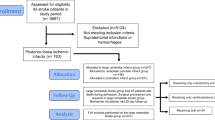Abstract
Surgical intervention (ventricular drainage or decompressive craniotomy) may be necessary in patients with cerebellar infarction if mass effect develops. However, patient selection and timing of surgery remain controversial, and there are few data on clinical signs in the early course that are predictive for outcome. The clinical course and neuroradiological features of 84 patients (aged 22–78, mean 58.5 years) with massive cerebellar infarction confirmed by computed tomography were prospectively observed for 21 days after admission and at 3-month follow-up using a standardized protocol. Data were gathered from 1992 to 1996 in 17 centers. The patients were assigned to three treatment groups depending on the decision of the primary caretaker: 34 underwent craniotomy and evacuation, 14 received ventriculostomy, and 36 were treated medically. Treatment groups differed regarding the level of consciousness, signs of mass effect in computed tomography and signs of brainstem involvement. The overall risk for poor outcome depended on the level of consciousness after clinical deterioration (odds ratio = 2.8). Subgroup analysis of awake/ drowsy or somnolent/stupor patients revealed no relationship to treatment. The vascular territory involved did not affect outcome. Surgical treatment for massive cerebellar infarctions was not found to be superior to medical treatment in awake/ drowsy or somnolent/stupor patients. Half of all patients deteriorating to coma treated with ventricular drainage or decompressive craniotomy had a meaningful recovery. We were unable to compare surgical versus medical therapy in this subgroup due to lack of control group. This study supports the notion that the level of consciousness is the most powerful predictor of outcome, superior to any other clinical sign and treatment assignment. Deterioration of consciousness typically occurred between days 2 and 4, with a maximum on day 3.
Similar content being viewed by others
Author information
Authors and Affiliations
Consortia
Additional information
Received: 24 October 1997 Received in revised form: 14 July 1998 Accepted: 13 August 1998
Rights and permissions
About this article
Cite this article
Jauss, M., Krieger, D., Hornig, C. et al. Surgical and medical management of patients with massive cerebellar infarctions: results of the German-Austrian Cerebellar Infarction Study. J Neurol 246, 257–264 (1999). https://doi.org/10.1007/s004150050344
Issue Date:
DOI: https://doi.org/10.1007/s004150050344




